能效等级标准
家电能效等级的意思

家电能效等级的意思家电能效等级是指根据国家标准,对家用电器的能源消耗进行评估和分类,以便消费者在购买时能够选择更节能、更环保的产品。
目前,我国实行的家电能效等级分为五级,分别为一级、二级、三级、四级和五级。
一、一级:最节能一级是最高的能效等级,代表着该产品具有最佳的节能性能。
这意味着它可以在使用过程中减少对环境的负担,并且在长期使用中也可以为消费者节省大量的电费支出。
目前市场上已经有很多一级节能产品,如空调、冰箱、洗衣机等。
二、二级:较为节能二级是次高的能效等级,代表着该产品具有较好的节能性能。
虽然它比一级要稍微逊色一些,但仍然比其他等级更加优秀。
这种产品不仅可以帮助消费者降低用电成本,还可以减少对环境造成的影响。
三、三级:普通节能三级是普通节能等级,代表着该产品具有普通的节能性能。
虽然它比较常见,但与其他低等效率产品相比,它仍然有很大的优势。
这种产品可以为消费者提供可靠的性能和适当的节能效果。
四、四级:较低节能四级是较低节能等级,代表着该产品的节能性能较差。
虽然这种产品在使用过程中可能会造成一定的负担,但它仍然比其他低效率产品更加环保和节能。
五、五级:最低效率五级是最低效率等级,代表着该产品具有最差的节能性能。
这种产品不仅会增加消费者的用电成本,还会对环境造成不良影响。
因此,在购买家电时,消费者应尽量避免选择五级或以下等级的产品。
总之,家电能效等级是指根据国家标准对家用电器进行评估和分类,并给出相应的符号标识以便消费者在购买时选择更加环保、节能和经济实惠的产品。
在购买家电时,消费者应注意选购高效率、高品质和可靠性强的产品,并且要注意使用方法和维护保养,以便延长其寿命并减少对环境造成不良影响。
能效等级标准
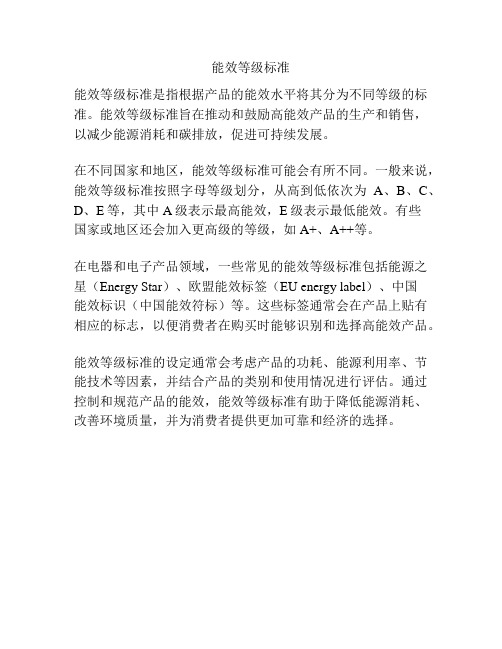
能效等级标准
能效等级标准是指根据产品的能效水平将其分为不同等级的标准。
能效等级标准旨在推动和鼓励高能效产品的生产和销售,以减少能源消耗和碳排放,促进可持续发展。
在不同国家和地区,能效等级标准可能会有所不同。
一般来说,能效等级标准按照字母等级划分,从高到低依次为A、B、C、D、E等,其中A级表示最高能效,E级表示最低能效。
有些
国家或地区还会加入更高级的等级,如A+、A++等。
在电器和电子产品领域,一些常见的能效等级标准包括能源之星(Energy Star)、欧盟能效标签(EU energy label)、中国
能效标识(中国能效符标)等。
这些标签通常会在产品上贴有相应的标志,以便消费者在购买时能够识别和选择高能效产品。
能效等级标准的设定通常会考虑产品的功耗、能源利用率、节能技术等因素,并结合产品的类别和使用情况进行评估。
通过控制和规范产品的能效,能效等级标准有助于降低能源消耗、改善环境质量,并为消费者提供更加可靠和经济的选择。
中国能效等级标准(一)
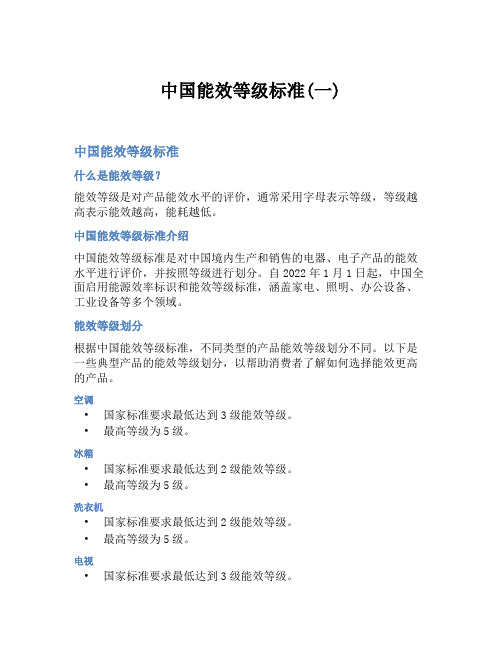
中国能效等级标准(一)中国能效等级标准什么是能效等级?能效等级是对产品能效水平的评价,通常采用字母表示等级,等级越高表示能效越高,能耗越低。
中国能效等级标准介绍中国能效等级标准是对中国境内生产和销售的电器、电子产品的能效水平进行评价,并按照等级进行划分。
自2022年1月1日起,中国全面启用能源效率标识和能效等级标准,涵盖家电、照明、办公设备、工业设备等多个领域。
能效等级划分根据中国能效等级标准,不同类型的产品能效等级划分不同。
以下是一些典型产品的能效等级划分,以帮助消费者了解如何选择能效更高的产品。
空调•国家标准要求最低达到3级能效等级。
•最高等级为5级。
冰箱•国家标准要求最低达到2级能效等级。
•最高等级为5级。
洗衣机•国家标准要求最低达到2级能效等级。
•最高等级为5级。
电视•国家标准要求最低达到3级能效等级。
•最高等级为5级。
选择能效等级高的产品的益处选择能效等级高的产品有以下益处:1.节能减排,对环境友好。
2.能迅速回收高价值的产品成本投资。
3.按使用时间计算,能够节约更多的电费。
总结中国能效等级标准对消费者来说是一个非常重要的标准,选择能效等级高的产品不仅有利于环境保护,还能节约成本。
所以在购买电器、电子产品时,应该仔细查看其能效等级。
如何查询产品的能效等级?在购买电器、电子产品时,查看能效等级并不难。
在中国境内生产和销售的电器、电子产品,都必须标注能源效率标识和能效等级。
消费者可以通过以下方式查询产品的能效等级:1.查看产品说明书和包装盒上的能源效率标识。
2.在国家能效信息查询平台上查询。
如何提高家庭用电效率除了选择能效等级高的产品外,我们还可以通过以下措施提高家庭用电效率:1.定期清理空调、冰箱、电视等电器的过滤器和散热器,以确保电器的散热效率和使用寿命。
2.合理选择电器的放置位置,尽量不让电器彼此挤在一起。
3.合理用电,避免用电高峰期。
4.采用高效的照明系统,使用能耗低的LED灯泡。
设备能效等级划分标准
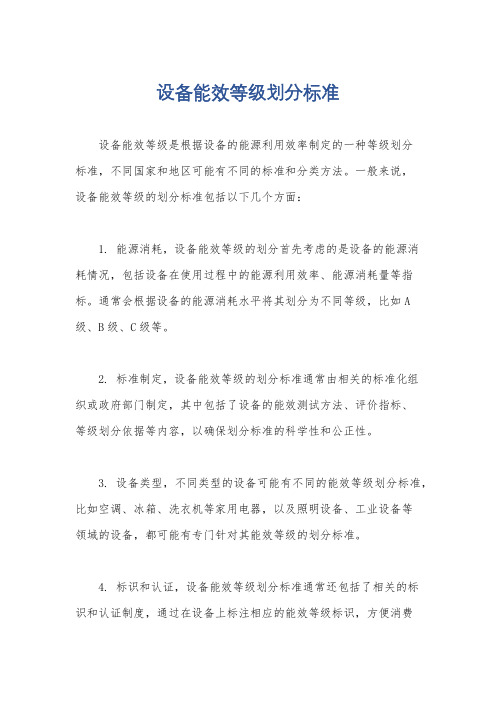
设备能效等级划分标准
设备能效等级是根据设备的能源利用效率制定的一种等级划分
标准,不同国家和地区可能有不同的标准和分类方法。
一般来说,
设备能效等级的划分标准包括以下几个方面:
1. 能源消耗,设备能效等级的划分首先考虑的是设备的能源消
耗情况,包括设备在使用过程中的能源利用效率、能源消耗量等指标。
通常会根据设备的能源消耗水平将其划分为不同等级,比如A 级、B级、C级等。
2. 标准制定,设备能效等级的划分标准通常由相关的标准化组
织或政府部门制定,其中包括了设备的能效测试方法、评价指标、
等级划分依据等内容,以确保划分标准的科学性和公正性。
3. 设备类型,不同类型的设备可能有不同的能效等级划分标准,比如空调、冰箱、洗衣机等家用电器,以及照明设备、工业设备等
领域的设备,都可能有专门针对其能效等级的划分标准。
4. 标识和认证,设备能效等级划分标准通常还包括了相关的标
识和认证制度,通过在设备上标注相应的能效等级标识,方便消费
者在购买时进行选择,也可以推动制造商提升产品的能效水平。
总的来说,设备能效等级划分标准是为了引导消费者购买节能
环保的设备,促进制造商提升产品能效水平,从而推动整个社会向
能源节约型和低碳环保方向发展。
不同国家和地区可能会有不同的
标准和划分方法,但其核心目的都是为了推动能源节约和环保发展。
中国能效等级划分标准

等级1表示产品节电已达到国际先进水平,能耗最低;等级2表示产品比较节电;等级3表示产品能源效率为我国市场的平均水平;等级4表示产品能源效率低于市场平均水平;等级5是产品市场准入指标,低于该等级要求的产品不允许生产和销售。
A+等级其能效指数为30%~42%,即在标准状况下实测耗电量相当于额定耗电量的30%~42%。
中国的空调、冰箱等产品能效等级分为5个等级。
世界上已经有100多个国家实施了能效标识制度。
为蓝白背景的彩色标识,分为1、2、3、4、5共5个等级,等级1表示产品达到国际先进水平,最节电,即耗能最低;等级2表示比较节电;等级3表示产品的能源效率为我国市场的平均水平;等级4表示产品能源效率低于市场平均水平;等级5是市场准入指标,低于该等级要求的产品不允许生产和销售。
能效标识为背部有粘性的,顶部标有“中国能效标识”(CHINA ENERGY LABEL)字样的彩色标签,一般粘贴在产品的正面面板上。
电冰箱能效标识的信息内容包括产品的生产者,型号,能源效率等级、24小时耗电量、各间室容积、依据的国家标准号。
空调能效标识的信息包括:产品的生产者,型号,能源效率等级、能效比、输入功率、制冷量、依据的国家标准号。
不同等级分别由不同的颜色和长度来表示。
最短的是深绿色,代表“未来四年的节能方向”,也就是国际先进水平,其次是绿色、黄色、橙色和红色。
等级指示色标是根据色彩所代表的情感安排的,其中红色代表禁止,橙色、黄色代表警告,绿色代表环保与节能。
等级介绍等级1产品节电已达到国际先进水平,最节电,能耗最低;等级2产品比较节电;等级3产品能源效率为中国市场的平均水平;等级4产品能源效率低于市场平均水平;等级5产品市场准入指标,低于该等级要求的产品不允许生产和销售。
家用电器能耗等级标准

3. 能源标准:许多国家和地区制定了针对特定家用电器的能源标准。这些标准规定了产品 在特定工作条件下的最大能源消耗限制。制造商必须确保其产品符合这些标准才能在市场上 销售。
4. 能源标识:一些国家和地区要求家用电器在产品上贴有能源标识,以显示产品的能源消 耗级别。这些标识通常包含产品的能源消耗量、能效等级和其他相关信息。
家用电器能耗等级标准
需要注意的是,具体的家用电器能耗等级标准会因国家和地区而异。因此,建议根据所在 地的法规和标准来了解和遵守相应的能耗等级标准。
家用电器能耗等级标准
家用电器的能耗等级标准通常由各国或地区的政府、标准化组织或能源机构制定和管理。 这些标准旨在推动能源效率和环境可持续性,鼓励生产和使用能效更高的家电产品,减少能 源消耗和碳排放。
以下是一些常见的家用电器能耗等级标准的例子:
1. 能效标签:许多国家和地区要求家用电器附带能效标签,以显示产品的能效等级。这些 标签通常使用字母或颜色编码,例如A+++(最高能效)到D(最低能效)等级。
国家能效等级新标准
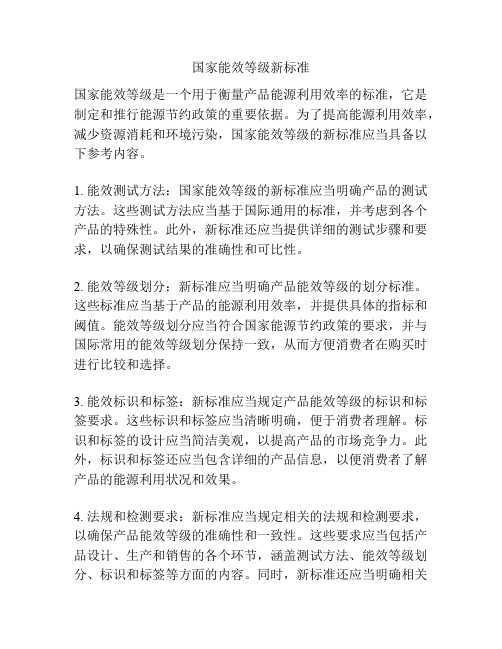
国家能效等级新标准国家能效等级是一个用于衡量产品能源利用效率的标准,它是制定和推行能源节约政策的重要依据。
为了提高能源利用效率,减少资源消耗和环境污染,国家能效等级的新标准应当具备以下参考内容。
1. 能效测试方法:国家能效等级的新标准应当明确产品的测试方法。
这些测试方法应当基于国际通用的标准,并考虑到各个产品的特殊性。
此外,新标准还应当提供详细的测试步骤和要求,以确保测试结果的准确性和可比性。
2. 能效等级划分:新标准应当明确产品能效等级的划分标准。
这些标准应当基于产品的能源利用效率,并提供具体的指标和阈值。
能效等级划分应当符合国家能源节约政策的要求,并与国际常用的能效等级划分保持一致,从而方便消费者在购买时进行比较和选择。
3. 能效标识和标签:新标准应当规定产品能效等级的标识和标签要求。
这些标识和标签应当清晰明确,便于消费者理解。
标识和标签的设计应当简洁美观,以提高产品的市场竞争力。
此外,标识和标签还应当包含详细的产品信息,以便消费者了解产品的能源利用状况和效果。
4. 法规和检测要求:新标准应当规定相关的法规和检测要求,以确保产品能效等级的准确性和一致性。
这些要求应当包括产品设计、生产和销售的各个环节,涵盖测试方法、能效等级划分、标识和标签等方面的内容。
同时,新标准还应当明确相关部门的职责和监督机制,以确保法规和检测要求的有效执行。
5. 激励措施和政策支持:为了推动能效等级标准的实施,国家应当制定相应的激励措施和政策支持。
这些措施可以包括财政补贴、税收优惠、市场准入限制等,以鼓励企业生产和消费符合能效等级标准的产品。
同时,政府还可以加强对产品能效等级的宣传和教育,以提高消费者的认知和理解度。
国家能效等级新标准的制定是一个复杂而系统的过程。
它需要考虑到产品的特殊性和市场需求,同时与国际通用标准保持一致。
通过确立能效测试方法、能效等级划分、能效标识和标签、法规和检测要求等内容,国家能效等级新标准可以为能源节约和环境保护提供有效的指导和支持,促进可持续发展的实现。
我国目前实行的五级能效标准
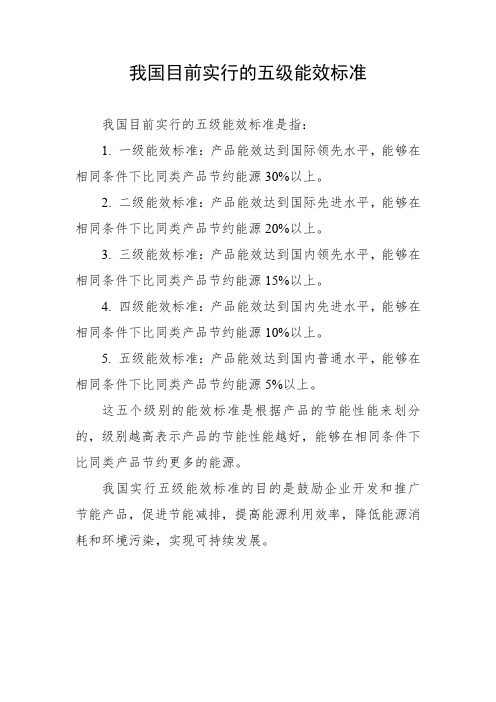
我国目前实行的五级能效标准
我国目前实行的五级能效标准是指:
1. 一级能效标准:产品能效达到国际领先水平,能够在相同条件下比同类产品节约能源30%以上。
2. 二级能效标准:产品能效达到国际先进水平,能够在相同条件下比同类产品节约能源20%以上。
3. 三级能效标准:产品能效达到国内领先水平,能够在相同条件下比同类产品节约能源15%以上。
4. 四级能效标准:产品能效达到国内先进水平,能够在相同条件下比同类产品节约能源10%以上。
5. 五级能效标准:产品能效达到国内普通水平,能够在相同条件下比同类产品节约能源5%以上。
这五个级别的能效标准是根据产品的节能性能来划分的,级别越高表示产品的节能性能越好,能够在相同条件下比同类产品节约更多的能源。
我国实行五级能效标准的目的是鼓励企业开发和推广节能产品,促进节能减排,提高能源利用效率,降低能源消耗和环境污染,实现可持续发展。
能效等级划分标准 详细说明
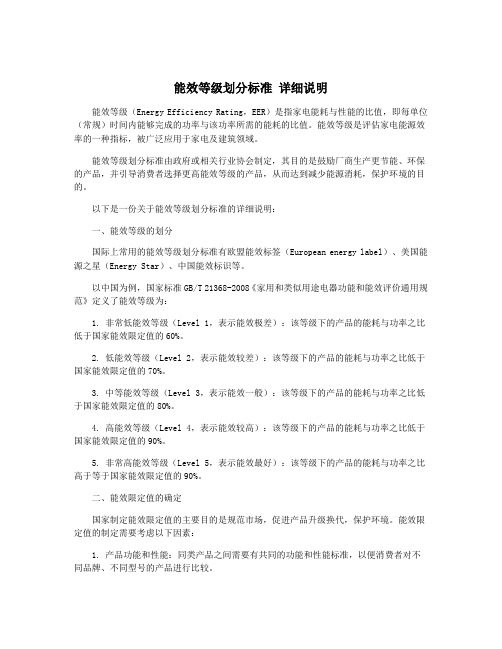
能效等级划分标准详细说明能效等级(Energy Efficiency Rating,EER)是指家电能耗与性能的比值,即每单位(常规)时间内能够完成的功率与该功率所需的能耗的比值。
能效等级是评估家电能源效率的一种指标,被广泛应用于家电及建筑领域。
能效等级划分标准由政府或相关行业协会制定,其目的是鼓励厂商生产更节能、环保的产品,并引导消费者选择更高能效等级的产品,从而达到减少能源消耗,保护环境的目的。
以下是一份关于能效等级划分标准的详细说明:一、能效等级的划分国际上常用的能效等级划分标准有欧盟能效标签(European energy label)、美国能源之星(Energy Star)、中国能效标识等。
以中国为例,国家标准GB/T 21368-2008《家用和类似用途电器功能和能效评价通用规范》定义了能效等级为:1. 非常低能效等级(Level 1,表示能效极差):该等级下的产品的能耗与功率之比低于国家能效限定值的60%。
2. 低能效等级(Level 2,表示能效较差):该等级下的产品的能耗与功率之比低于国家能效限定值的70%。
3. 中等能效等级(Level 3,表示能效一般):该等级下的产品的能耗与功率之比低于国家能效限定值的80%。
4. 高能效等级(Level 4,表示能效较高):该等级下的产品的能耗与功率之比低于国家能效限定值的90%。
5. 非常高能效等级(Level 5,表示能效最好):该等级下的产品的能耗与功率之比高于等于国家能效限定值的90%。
二、能效限定值的确定国家制定能效限定值的主要目的是规范市场,促进产品升级换代,保护环境。
能效限定值的制定需要考虑以下因素:1. 产品功能和性能:同类产品之间需要有共同的功能和性能标准,以便消费者对不同品牌、不同型号的产品进行比较。
2. 市场需求:能效限定值需要根据市场需求进行调整,以达到促进产品升级与降低家用电器能耗的目的。
3. 技术可行性和经济可行性:能效限定值需要符合技术和经济可行性的原则,不能过高或过低。
国标能效等级
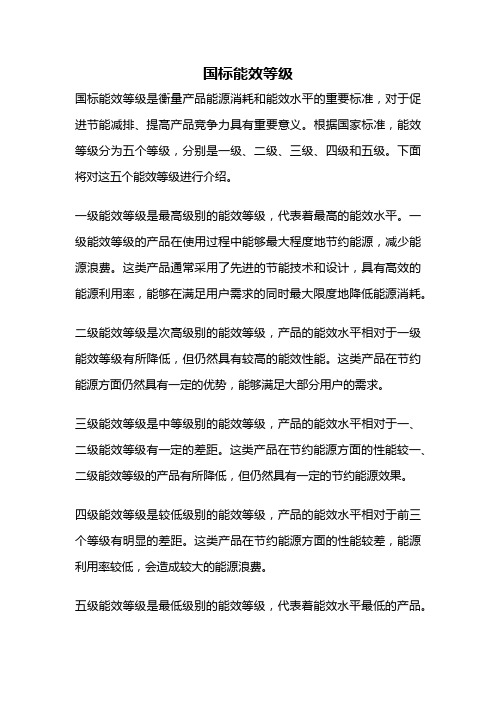
国标能效等级国标能效等级是衡量产品能源消耗和能效水平的重要标准,对于促进节能减排、提高产品竞争力具有重要意义。
根据国家标准,能效等级分为五个等级,分别是一级、二级、三级、四级和五级。
下面将对这五个能效等级进行介绍。
一级能效等级是最高级别的能效等级,代表着最高的能效水平。
一级能效等级的产品在使用过程中能够最大程度地节约能源,减少能源浪费。
这类产品通常采用了先进的节能技术和设计,具有高效的能源利用率,能够在满足用户需求的同时最大限度地降低能源消耗。
二级能效等级是次高级别的能效等级,产品的能效水平相对于一级能效等级有所降低,但仍然具有较高的能效性能。
这类产品在节约能源方面仍然具有一定的优势,能够满足大部分用户的需求。
三级能效等级是中等级别的能效等级,产品的能效水平相对于一、二级能效等级有一定的差距。
这类产品在节约能源方面的性能较一、二级能效等级的产品有所降低,但仍然具有一定的节约能源效果。
四级能效等级是较低级别的能效等级,产品的能效水平相对于前三个等级有明显的差距。
这类产品在节约能源方面的性能较差,能源利用率较低,会造成较大的能源浪费。
五级能效等级是最低级别的能效等级,代表着能效水平最低的产品。
这类产品在能源消耗方面表现较差,能源利用率低,会造成较大的能源浪费。
建议用户在购买产品时尽量避免选择五级能效等级的产品,以减少能源消耗和环境负担。
国标能效等级的设立旨在引导企业和用户选择节能环保的产品,促进节能减排和可持续发展。
作为消费者,我们可以通过选择能效等级较高的产品来降低能源消耗,为环境保护做出贡献。
而作为企业,通过提高产品的能效等级,不仅可以满足市场需求,提高产品竞争力,还可以减少能源成本,降低生产成本。
国标能效等级是衡量产品能源消耗和能效水平的重要标准。
不同能效等级的产品在节约能源方面有着不同的性能表现,消费者在购买产品时应根据实际需求选择合适的能效等级的产品。
同时,企业应积极提高产品的能效等级,推动节能减排和可持续发展。
电动机 能效等级
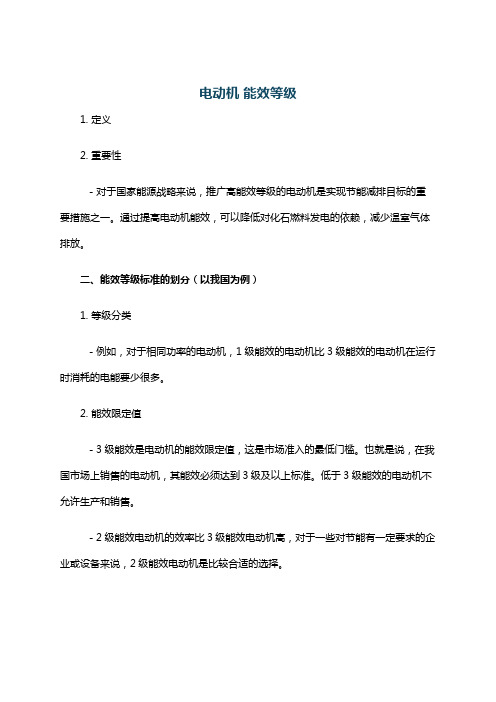
电动机能效等级1. 定义2. 重要性- 对于国家能源战略来说,推广高能效等级的电动机是实现节能减排目标的重要措施之一。
通过提高电动机能效,可以降低对化石燃料发电的依赖,减少温室气体排放。
二、能效等级标准的划分(以我国为例)1. 等级分类- 例如,对于相同功率的电动机,1级能效的电动机比3级能效的电动机在运行时消耗的电能要少很多。
2. 能效限定值- 3级能效是电动机的能效限定值,这是市场准入的最低门槛。
也就是说,在我国市场上销售的电动机,其能效必须达到3级及以上标准。
低于3级能效的电动机不允许生产和销售。
- 2级能效电动机的效率比3级能效电动机高,对于一些对节能有一定要求的企业或设备来说,2级能效电动机是比较合适的选择。
- 1级能效电动机代表了目前较高的能效水平,通常在对节能要求非常严格的场合,如一些绿色建筑中的空调系统、高效节能的工业生产线等会优先选用1级能效电动机。
1. 电动机设计- 绕组材料:采用高导电率的绕组材料,如优质的铜材,可以降低绕组电阻,减少电能在绕组中的损耗,从而提高电动机的能效。
例如,纯度更高、导电性更好的铜绕组可以使电动机的效率有所提升。
- 磁路设计:合理的磁路设计可以减少磁滞损耗和涡流损耗。
例如,采用高性能的磁性材料,优化电机铁芯的形状和尺寸等,可以提高电动机的能效。
2. 制造工艺- 精确的制造工艺可以保证电动机各部件的精度和装配质量。
例如,在电机转子和定子的加工过程中,如果加工精度高,转子和定子之间的气隙均匀,就可以减少因气隙不均匀而产生的附加损耗,提高电动机的运行效率。
- 良好的绝缘工艺也很重要。
优质的绝缘材料和合理的绝缘工艺可以减少漏电现象,提高电动机的能效。
四、能效等级标识与识别1. 标识内容- 电动机的能效等级标识通常包含电动机的型号、额定功率、能效等级(1级、2级或3级)、效率值等信息。
- 例如,在电动机的铭牌上或者单独的能效标识贴纸上,可以清晰地看到这些信息。
能效等级怎么划分

能效等级怎么划分能效等级是用于评估和比较电器、电子产品、汽车等能源消耗效率的标准。
它是根据产品在使用过程中所消耗的能量来划分的,通常通过符号或字母来表示。
下面我将详细讲述能效等级的划分方式。
1. 能源消耗测量:划分能效等级的第一步是对产品在使用过程中的能源消耗进行测量。
这可以通过实验室测试或其他标准化方法完成,以确保结果的准确性和可靠性。
对于不同类型的产品,可能会有不同的测试标准和程序。
2. 能源消耗指标:通过能源消耗测量得到的数据,通常会计算出一个能源消耗指标,用于比较不同产品之间的能效水平。
这个指标可以是电器的能耗值(如每小时耗电量)、燃料的能耗值(如每百公里油耗量)等。
这个指标反映了产品在使用过程中所消耗的能量。
3. 划分标准:根据国家或地区的法律法规和行业政策,以及相关的国际标准,制定能效等级的划分标准。
根据能源消耗指标的不同范围和数值,将产品划分为不同的等级。
通常,能效等级越高,产品的能源消耗越低,能效越好。
4. 符号或字母表示:为了方便消费者理解和比较不同产品的能效等级,常采用符号或字母来表示。
这些符号或字母通常以直观易懂的方式呈现,例如颜色、箭头、星级等。
消费者可以通过这些符号或字母来选择更节能的产品。
5. 标签和认证:为了确保能效等级的公平和可信度,一些国家和地区要求在产品上贴上能效标签,以显示其能效等级。
此外,一些产品可能需要通过第三方机构的认证,以证明其能效等级的准确性和合规性。
需要注意的是,不同的国家或地区可能有不同的能效等级划分标准和表示方式。
因此,在购买产品时,消费者应该了解和熟悉自己所在地区的能效等级体系,以便正确理解和选择符合自己需求的产品。
能效等级的划分对于节约能源、减少碳排放和保护环境具有重要意义。
它促使制造商在产品研发和生产中更加注重能源效率,推动市场向更节能、更环保的方向发展。
同时,它也引导消费者在购买过程中更加关注能效问题,鼓励选择具有高能效等级的产品,共同为可持续发展做出贡献。
能源消耗评估常用能效等级解释标准

能源消耗评估常用能效等级解释标准背景随着全球气候变化和环境保护的日益重要,对能源消耗的评估和管理变得越来越关键。
为了帮助消费者了解产品的能源效率,许多国家和地区制定了能效等级标准。
本文将介绍常用的能效等级解释标准,以帮助人们更好地理解和比较产品的能源消耗。
能效等级解释标准1. 能效等级: 能效等级通常用字母表示,从高到低依次为A、B、C、D等。
字母等级越高,表示产品的能源效率越高。
能效等级: 能效等级通常用字母表示,从高到低依次为A、B、C、D等。
字母等级越高,表示产品的能源效率越高。
2. 能效比: 能效比是一个衡量产品能源效率的指标,通常以数值表示。
能效比数值越高,表示产品能够更有效地利用能源。
例如,能效比为3的产品比能效比为2的产品更节能。
能效比: 能效比是一个衡量产品能源效率的指标,通常以数值表示。
能效比数值越高,表示产品能够更有效地利用能源。
例如,能效比为3的产品比能效比为2的产品更节能。
3. 年度能耗: 年度能耗指产品在一年内所消耗的能源数量。
一般情况下,能源消耗越低,产品的年度能耗越少。
年度能耗: 年度能耗指产品在一年内所消耗的能源数量。
一般情况下,能源消耗越低,产品的年度能耗越少。
4. 比较基准: 为了更好地比较产品的能源消耗,常常采用比较基准。
比较基准是指将同类型产品的能源消耗进行统计分析后得出的平均值或基准值。
通过与比较基准进行对比,可以判断产品的能源消耗是否高于或低于平均水平。
比较基准: 为了更好地比较产品的能源消耗,常常采用比较基准。
比较基准是指将同类型产品的能源消耗进行统计分析后得出的平均值或基准值。
通过与比较基准进行对比,可以判断产品的能源消耗是否高于或低于平均水平。
5. 能源标签: 能源标签是在产品上标明能源效率等级和相关信息的标志。
通过能源标签,消费者可以直观地了解产品的能源消耗情况,从而做出更明智的购买决策。
能源标签: 能源标签是在产品上标明能源效率等级和相关信息的标志。
能效管理等级划分要求及评定标准

能效管理等级划分要求及评定标准
能效等级是表示家用电器产品能效高低差别的一种分级方法,它主要是依据能效比来划分的。
我国把能效比3.40以上或电冰箱能效标识为1、2级的定为一级能效。
具体来说,能效等级的划分标准如下:
1.等级1表示产品达到国际先进水平,最节电,即耗能最低;
2.等级2表示比较节电;
3.等级3表示产品的能源效率为我国市场的平均水平;
4.等级4表示产品能源效率低于市场平均水平;
5.等级5是产品市场准入指标,低于该等级要求的产品不允许生产和销售。
根据不同等级要求,对于各种家用电器,都规定了相应的能效等级。
其中,空调的能效等级分为三级,电视、冰箱、洗衣机等其他家电的能效等级也分为五级。
在评定能效等级时,通常会考虑产品的能效比、待机功率、关机功率、关机电流等参数。
其中,能效比是指空调在制冷运行时,制冷量与有效输入功率之比,这个数值越高,产品的能效等级也就越高。
待机功率是指在待机状态下输入功率的均值,这个数值越低,产品的耗电量就越少。
关机功率是指空调在关机状态下输入功率的均值,这个数值越低,产品的耗电量就越少。
关机电流是指空调在关机状态下输入电流的均值,这个数值越低,产品的安全性就越好。
需要注意的是,不同品牌和型号的家用电器,其能效等级标准可能会有所不同。
因此,在购买家用电器时,应关注产品的能效等级和能效标识,以便选择更节能、更环保的产品。
能效等级适用范围
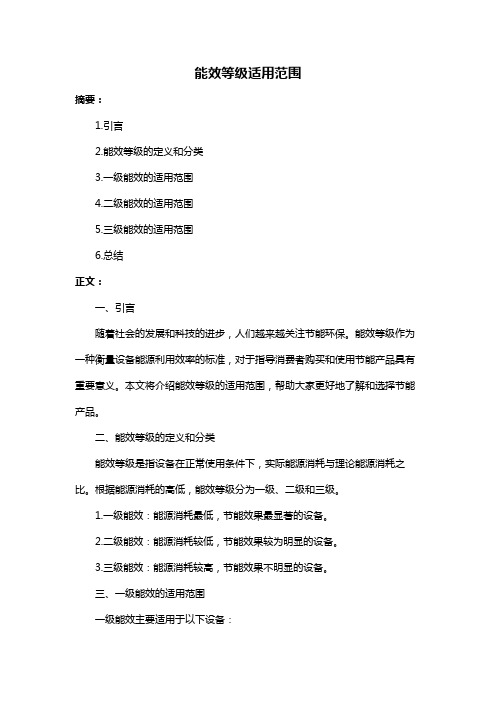
能效等级适用范围摘要:1.引言2.能效等级的定义和分类3.一级能效的适用范围4.二级能效的适用范围5.三级能效的适用范围6.总结正文:一、引言随着社会的发展和科技的进步,人们越来越关注节能环保。
能效等级作为一种衡量设备能源利用效率的标准,对于指导消费者购买和使用节能产品具有重要意义。
本文将介绍能效等级的适用范围,帮助大家更好地了解和选择节能产品。
二、能效等级的定义和分类能效等级是指设备在正常使用条件下,实际能源消耗与理论能源消耗之比。
根据能源消耗的高低,能效等级分为一级、二级和三级。
1.一级能效:能源消耗最低,节能效果最显著的设备。
2.二级能效:能源消耗较低,节能效果较为明显的设备。
3.三级能效:能源消耗较高,节能效果不明显的设备。
三、一级能效的适用范围一级能效主要适用于以下设备:1.家用电冰箱:具有较低的能源消耗,可为家庭用户提供长时间稳定的保鲜功能。
2.空调:在保证舒适度的前提下,实现低能耗运行,降低用户电费支出。
3.洗衣机:采用先进的节能技术,减少能源消耗,降低家庭用水成本。
4.电视机:优化电源管理,降低待机功耗,实现节能减排。
四、二级能效的适用范围二级能效主要适用于以下设备:1.热水器:在保证热水供应的同时,实现较低的能源消耗。
2.照明产品:采用高效率的光源,降低照明设备的能耗。
3.电饭煲:在保证食物口感的同时,降低能源消耗。
4.微波炉:采用高效率磁控管,降低运行功耗。
五、三级能效的适用范围三级能效主要适用于以下设备:1.电暖气:在寒冷地区为用户提供温暖的同时,能源消耗较高。
2.烤箱:在烹饪过程中,能源消耗相对较高。
3.电风扇:在炎热季节为用户提供凉爽的同时,能源消耗较高。
4.吸尘器:在清洁过程中,能源消耗较高。
六、总结了解能效等级的适用范围,有助于我们在购买和使用设备时,更加注重节能环保。
选择一级和二级能效产品,有助于降低家庭能源消耗,实现绿色生活。
国家用电能效等级
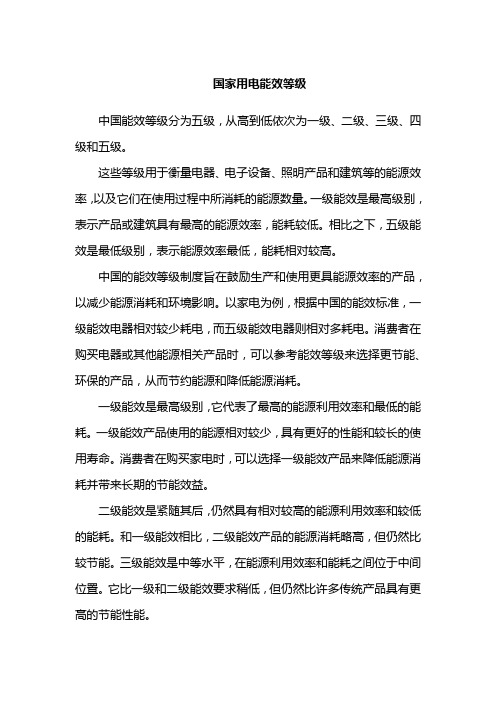
国家用电能效等级
中国能效等级分为五级,从高到低依次为一级、二级、三级、四级和五级。
这些等级用于衡量电器、电子设备、照明产品和建筑等的能源效率,以及它们在使用过程中所消耗的能源数量。
一级能效是最高级别,表示产品或建筑具有最高的能源效率,能耗较低。
相比之下,五级能效是最低级别,表示能源效率最低,能耗相对较高。
中国的能效等级制度旨在鼓励生产和使用更具能源效率的产品,以减少能源消耗和环境影响。
以家电为例,根据中国的能效标准,一级能效电器相对较少耗电,而五级能效电器则相对多耗电。
消费者在购买电器或其他能源相关产品时,可以参考能效等级来选择更节能、环保的产品,从而节约能源和降低能源消耗。
一级能效是最高级别,它代表了最高的能源利用效率和最低的能耗。
一级能效产品使用的能源相对较少,具有更好的性能和较长的使用寿命。
消费者在购买家电时,可以选择一级能效产品来降低能源消耗并带来长期的节能效益。
二级能效是紧随其后,仍然具有相对较高的能源利用效率和较低的能耗。
和一级能效相比,二级能效产品的能源消耗略高,但仍然比较节能。
三级能效是中等水平,在能源利用效率和能耗之间位于中间位置。
它比一级和二级能效要求稍低,但仍然比许多传统产品具有更高的节能性能。
四级能效是标准能效等级。
产品达到这个等级需要满足一系列的能效指标,旨在确保产品具有一定的能源节约效果。
五级能效是最低级别,代表了最低的能源效率和相对较高的能耗。
这些产品使用更多的能源,能效较低。
- 1、下载文档前请自行甄别文档内容的完整性,平台不提供额外的编辑、内容补充、找答案等附加服务。
- 2、"仅部分预览"的文档,不可在线预览部分如存在完整性等问题,可反馈申请退款(可完整预览的文档不适用该条件!)。
- 3、如文档侵犯您的权益,请联系客服反馈,我们会尽快为您处理(人工客服工作时间:9:00-18:30)。
2
What if my EPS meets different efficiency levels when tested at different voltage/frequency combinations? Some organizations allow manufacturers to mark an EPS capable of operating at multiple voltages/frequencies as meeting the performance requirements in only one voltage/frequency combination. For illustrative purposes, the table below provides some sample marks and an explanation of each. Sample Mark Explanation
49 to ≤ 250 W
≤ 0.210 ≤ 0.500
VI
250 W
Multiple-Voltage 0 to ≤ 1 W Any ≤ 0.300 1 to ≤ 49 W 49 W ≥ 0.497 Pno + 0.067 ≥ 0.075 ln(Pno) + 0
Reserved for future use.
Pno is the Nameplate Output Power of the unit under test. In Australia and New Zealand, AC-AC external power supplies are not required to meet the no-load mode power requirements. 4 “ln” refers to the natural logarithm. 5 A low-voltage model is an EPS with nameplate output voltage of less than 6 volts and nameplate output current greater than or equal to 550 milliamperes. A basic-voltage model is an EPS that is not a low-voltage model.
International Efficiency Marking Protocol for External Power Supplies Version 3.0, September 2013
This fact sheet describes the international efficiency marking protocol for external power supplies (EPSs) developed by the U.S. Environmental Protection Agency and now maintained by the U.S. Department of Energy (DOE). Sources for additional information are listed at the end of this document. This version, updated as of September 2013, replaces an earlier document released in October 2008. What is the international efficiency marking protocol? The international efficiency marking protocol provides a system for EPS manufacturers to designate the minimum efficiency performance of an EPS, so that finished product manufacturers and government representatives can easily determine a unit’s efficiency. This mark does not serve as a consumer information label, but rather demonstrates the performance of the EPS when tested to the internationally supported test methods. (See For More Information on page 3 for references to these test procedures.) What does the international efficiency mark look like? The international efficiency mark consists of a Roman numeral that corresponds to specific minimum Active and No-Load efficiency levels (as well as a power factor requirement for level V) and is printed/applied by the manufacturer on the EPS nameplate, product packaging, or accompanying documentation. Format: Font: Size: Color: Placement: Roman numeral: I, II, III, IV, V, VI, etc. Times Roman preferred (or other plain serif fonts). Legible and indelible. Text to contrast with the nameplate background, unless incorporated in the case molding. Preferably on the EPS nameplate; however, placement on the product packaging or accompanying documentation is also acceptable. The exact location is at the discretion of the manufacturer. The text “Efficiency Level” shown in the example below is optional.
II
10 to 250 W 0 to < 10 W
III
10 to 250 W
IV
0 to 250 W
≤ 0.5
V
≥ 50 to ≤ 250 W
Single-Voltage 0 to ≤ 1 W 0 to ≤ 49 W AC-DC: ≤ 0.100 AC-AC: ≤ 0.210
1 to ≤ 49 W 49 to ≤ 250 W 250 W
1
Note that some jurisdictions have additional sampling requirements that must be met when testing products.
Performance Requirements Mark Nameplate Output Power 2 (Pno) No-Load Mode 3 Power Nameplate Output Power (Pno)
Average Efficiency in Active Mode
4
Power Factor
I
Used if none of the other criteria are met. 0 to ≤ 10 W ≤ 0.75 ≤ 1.0 ≤ 0.5 ≤ 0.75 0 to < 1 W 1 to < 49 W 49 W 0 to 1 W 1 to 49 W 49 to 250 W 0 to < 1 W 1 to 51 W 51 to 250 W 0 to < 50 W AC-DC: ≤ 0.3 AC-AC: ≤ 0.5 ≤ 0.5 0 to ≤ 1 W > 1 to ≤ 49 W > 49 to 250 W ≥ 0.39 Pno ≥ 0.107 ln(Pno) + 0.39 ≥ 0.82 ≥ 0.49 Pno ≥ 0.09 ln(Pno) + 0.49 ≥ 0.84 ≥ 0.5 Pno ≥ 0.09 ln(Pno) + 0.5 ≥ 0.85 Basic Voltage: ≥ 0.480 Pno + 0.140 5 Low Voltage : ≥ 0.497 Pno + 0.067 Basic Voltage: ≥ 0.0626 ln(Pno) + 0.622 Low Voltage: ≥ 0.0750 ln(Pno) + 0.561 Basic Voltage: ≥ 0.870 Low Voltage: ≥ 0.860 Basic Voltage: ≥ 0.5 Pno + 0.16 Low Voltage: ≥ 0.517 Pno + 0.087 Basic Voltage: ≥ 0.071 ln(Pno) − 0.0014 Pno + 0.67 Low Voltage: ≥ 0.0834 ln(Pno) − 0.0014 Pno + 0.609 Basic Voltage: ≥ 0.880 Low Voltage: ≥ 0.870 ≥ 0.875 Not Applicable EPSs with ≥ 100 watts input power must have a true power factor ≥ 0.9 at 100% of rated load when tested at 115 volts/60Hz. Not Applicable Not Applicable Not Applicable
